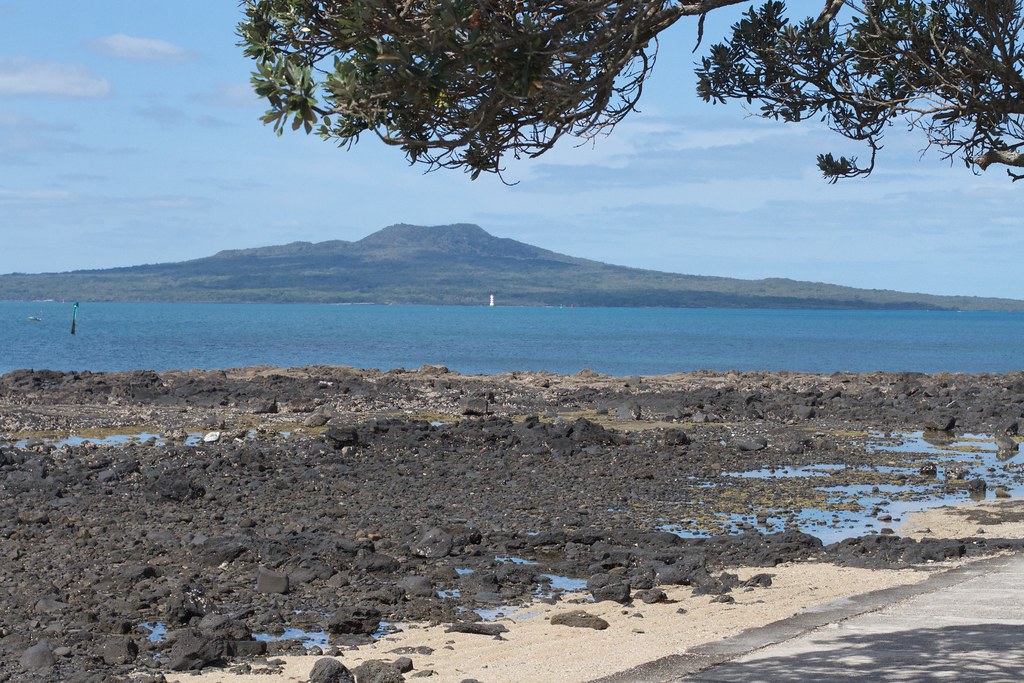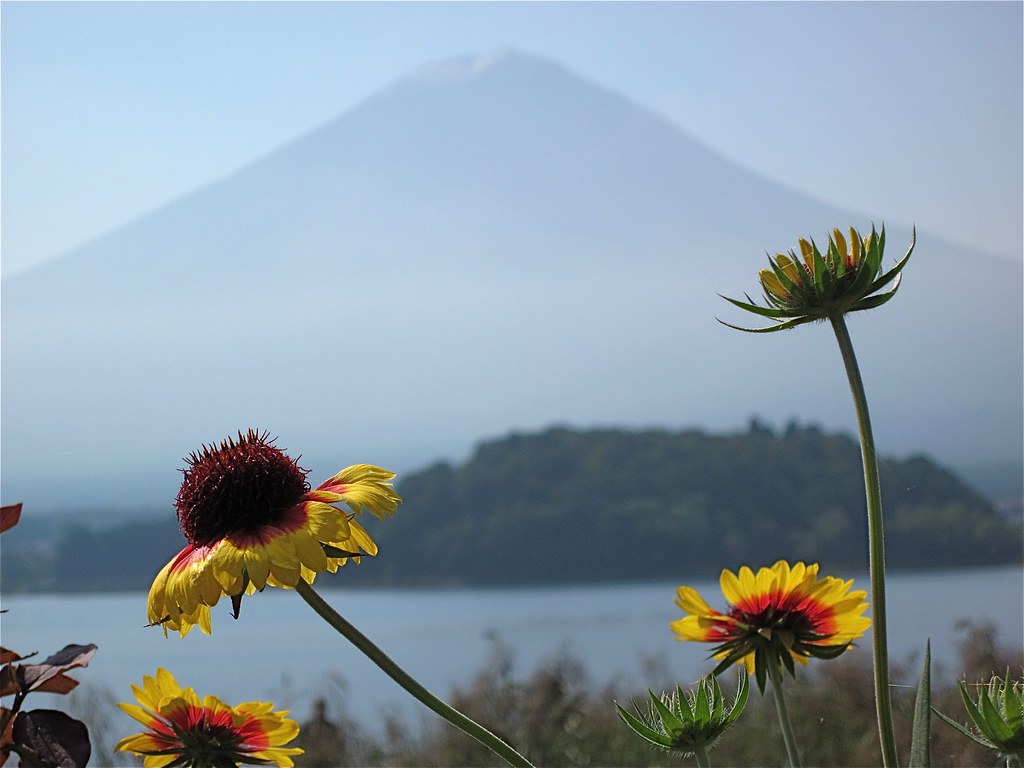It has been a while since I gave thought time to volcanoes, how about you?
And of all unlikely starts to the process, this came via a tweet from Stephen Downes referencing a new content site which he noted must be just starting out because 3 of the top search results included courses about volcanoes.
This triggers my neurons down the path of my academic route, which did not start off pointing to where I am now. But after earning my BS in Geology, I decided for a reason I cannot quite find that for grad school I wanted to go to a place first, that was as radically different from the East Coast place I had never traveled from (Baltimore), but also had a few researchers in the field of volcanoes and volcanic landscapes.
That is how I ended up at the Geology department at Arizona State University and specifically to work with Dr Michael Sheridan, whose works in these large scale eruptions that produce a funky rock type called “ignimbrites.” I may have read about Mike in my petrology or structural geology class.
Without too much winding history, I did a Masters Thesis using Landsat satellite images coupled with field work and some kind of reflection spectroscopy applied to the Bishop Tuff in easter California (an area where Mike was a top expert on). I cannot do justice to the warmth and also, a slightly crazed energy to Mike (at a dinner table a story he told with great animation, he almost turned into a giant flying iguana). Muc much later, I got to meet up with Mike after he retired in upstate New York, where of all things, and this was his style, he collected an raised llamas.
Much later I put a marker for this on my first web site with a web page for Ash Flow Zones of the Bishop Tuff: Detailed Mapping with Landsat Thematic Mapper (note the URL sarcasm).

I have all my thesis files on a hard drive rescued from floppy disks, though they are trapped in MS Word 3.0 files and PICT images. I had started a project to digitize this, but the project went a far as one post:
Though I have found since than that I can open all the old files in LibreOffice, and maybe it’s time to sort out where/how to publish online.
Not really sure I wanted to go out in the world, I signed on to the PhD program, shifting to work with Dr Susan Kiefer as my advisor, a well known US Geological Survey scientist. Sue was an incredible influence on the importance of clear and understand writing (she broke my passive tense habit). We spent a year working on a research paper that was published in the leading Geology publication- they had a strict 4 printed page limit that forced the writing again to be tight.
Want to get really geeky? This was based on documentation of a much smaller event than the May 18, 1980 big “blast”. A USGS geologist named Rick Hoblitt had taken a series of photos as and cloud of ash and gas rushed down a channel on the flanks of the volcano. Quite cleverly, Hoblitt had an old fashioned time stamp on the photos, and by mapping the location of the front edge to the map locations, he did some old school math to chart the velocity of this flow, that was published in a report.
The research I did with Sue was to analyze this volcanic flow using the physics of fluid and gas dynamics, and came to a conclusion that the shape of the channel forced the volcanic flow to act like it went through a “hydraulic jump” (I am getting fuzzy on the details, but it’s all in the paper!)
Hydraulics of the August 7, 1980, pyroclastic flow at Mount St. Helens, Washington was published in Geology November 1, 1991 (holy bleep, 31 years ago). I created my own copy of it on my own SPLOT powered site.

One of the biggest things I got to do in this period was to present some our preliminary research at the International Volcanological Congress (IAVCEI) conference in Mainz, Germany, in 1990. Besides being my first international travel trip where I wandered southern Germany for an extra 2 weeks, in a time of unbridled optimism with the impending demolition of the Berlin wall), there was a unique evening presentation from a French couple that I will come back to down post.
What happened to this career in volcanology? That’s another story, but let’s say my passion for narrow research waned, and I made a wild leap into education that, almost by a sheer accident, had land a job 1991 as a “Instructional Programmer/Analytical Systems” at the Maricopa Community Colleges.
The volcano life was left behind… but not exactly.
I ended up making use of it as a subject matter in 1994, when this odd thing I found called “Mosaic” led me to create a tutorial aimed to help educators learn how to make web pages… the pure way, from raw HTML.
I saw often that tutorials led you through pretty meaningless demo exercises, and I wanted my tutorial to teach the concepts, but use as an example, some real content. So I reached for what I knew, and would also be of interest… yes! Volcanoes.
That tutorial, Writing HTML, had so many rippling effects I might not know them all. One was finding out a teacher in a small town in Iceland translated my tutorial into Icelandic, and ultimately leading to an invitation to do some workshops in Reykjavik in 2000. Some Canadian guy named Brian was teaching at a school in Mexico, learned HTML from my site, and eventually led to some amazing work we did for decades after.
But back to the Volcanoes. For Writing HTML I guided the learner through a series of lessons and activities where they would add bit by bit not only HTML, but audio, video, javascript, even… Java md Shockwave, creating a site called Volcano Web

For years I heard from people who said they learned HTML from “the Volcano thing”.
This story has flowed down the hill long enough like ropy lava, but one more place I put my Volcano experience to work was one of the first things I tried in flickr with it’s notes feature that allowed me to add pop up notes to portions of an image. I felt like a worthy example was taking a well known diagram used in volcanology to classify types of volcanoes, that pitted on a graph the explosiveness (Y axis) versus height of the eruption column. I decided to overlay the chart I always saw in my Geology textbooks, with photos of these kinds of volcanoes.
I won’t show above, but if you visit the flickr page, each photo is hyperlinked to a pop up note that even has an out going link to more information about that type of volcano. Folks this was doing image annotation in 2004! And better than that, and reason number 55,203 why I love flickr is THAT IT STILL WORKS! Go try it.

Circle to Now and Fire of Love
I forget who sent me a link, but thank you, as I am eager, maybe next week, when the streaming comes available for the National Geographic documentary called “Fire of Love”

Before you think I am gushing over some romance flickr, read:
Katia and Maurice Krafft loved two things — each other and volcanoes. For two decades, the daring French volcanologist couple roamed the planet, chasing eruptions and documenting their discoveries. Ultimately, they lost their lives in a 1991 volcanic explosion, leaving a legacy that forever enriched our knowledge of the natural world. Director Sara Dosa and the filmmaking team fashion a lyrical celebration of the intrepid scientists’ spirit of adventure, drawing from the Kraffts’ spectacular archive. FIRE OF LOVE tells a story of primordial creation and destruction, following two bold explorers as they venture into the unknown, all for the sake of love.
https://films.nationalgeographic.com/fire-of-love
Okay, do you remember reading above (you do read all my words, right) about a presentation one evening at the 1990 IAVCEI conference in Mainz? The speakers that night were Katia and Maurice Krafft! They were well known in the research circles for getting incredible documentation of active volcanoes.
I remember one story they told, over photos, about going out on a lake in an active volcano (was it Indonesia?) where the risk was the high acidity of the water and to do those they used a titanium canoe, that was hissing and starting to melt by the time they returned.
In the volcano research field, there is a subset of scientists (I was not in it) who chose and relished the risk of doing the dangerous field work on active volcanoes. The Kraffts were not academic scientists but were highly regarded in the field.
The movie will not hide the fact that the Kraffts died in 1991 doing what they loved while observing/filming a volcano in Japan. And hah, what I am telling I have already blogged about on a post from the 30th anniversary of the 1980 Mount St Helens eruption.
But the story of Harry is so moving, I have to replay it. I met Harry Glicken on a field trip to Mount St Helens in 1989.
Harry was a graduate student at University of California Santa Barbara, and it was actually even before he started his program that he became a research assistant in the field to David Johnston, who died being the closest person to Mount St Helens at the Coldwater Ridge observation post.
Most ironically, Harry was supposed to be at Coldwater Ridge on May 18, but had to be at UCSB, so Johnston filled in for him and died in the volcanic blast.
I met Harry a few times at conferences and on field trips. He was kind of an unlikely geologist, today, you might peg him at first glance as a computer geek, but he was the real deal volcanologist- super serious and hilariously funny I recall. On that field trip I was on, Harry retold the story. To me, he seemed a bit haunted by the experience, but he never left the field.
Harry was in that group of volcanologists who had a hunger to be in the danger zone, on the flanks of active volcanoes. Ironically, he cheated death at a volcano once only to be among a group of 40 some other scientists killed at a 1991 eruption in Japan along with the Kraffts.
I have always been more of the “stay interested in volcanoes at a safe distance” but have always enjoyed admiring the landforms, and respecting people like Harry and the Kraffts who chased them up close.
That’s me and some volcanoes.
Featured Image:









Why would you find unlikely that I would reference volcanos? Volcanos are really interesting. I think about them a lot. One of them (in Iceland) canceled my one and only speaking invitation to Finland.
In fact, I searched specifically for volcanos on the site, and was disappointed that only three of the eight search result were about volcanos.
Fair enough, and I meant unlikely more in the sense of “ironic” not that Stephen does not appreciate volcanoes. It was more of a thanks, since your mere mention of volcanoes triggered my own path of memories.
But the other point was the collection of volcano content at EdLeed was pretty thin on variety being just courses, and missed out on the richness of the stories of the Kraffts